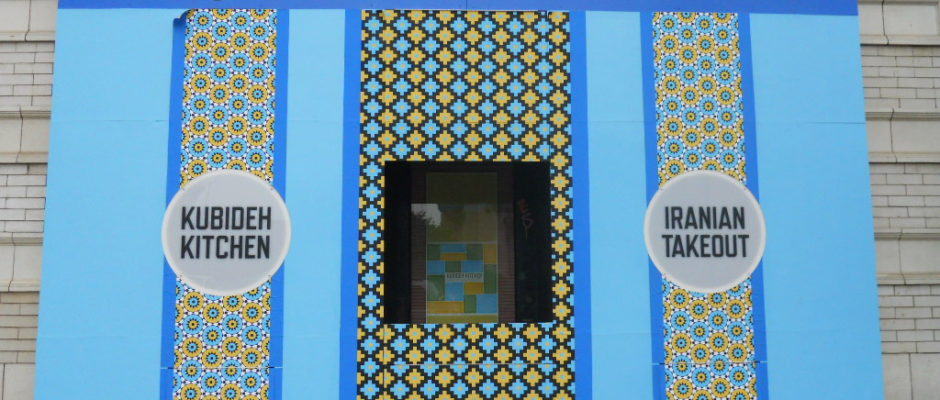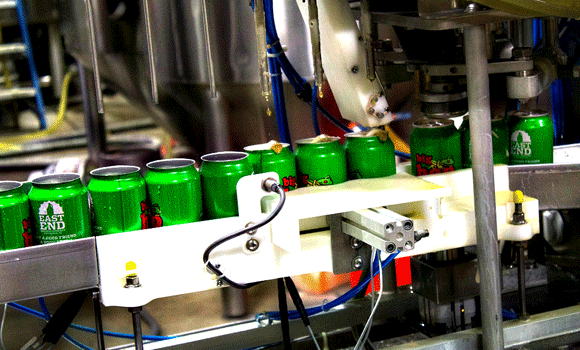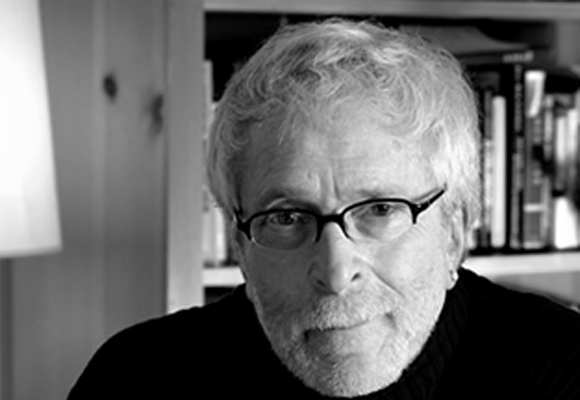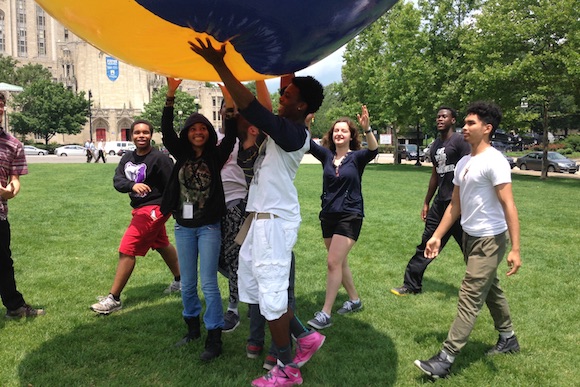At Conflict Kitchen, an experimental art project in Pittsburgh, food is the medium.
The idea evolved out of another performance art-meets-restaurant concept called Waffle Shop: A Reality Show, a project spearheaded by Carnegie Mellon University art professor Jon Rubin and his students. Their goal was to find new ways to generate support for performance art within the urban core.
Located in the East Liberty neighborhood of Pittsburgh, the waffle restaurant produced a live streaming talk show featuring its customers — the patrons were also the guests.
Waffle Shop opened in 2008 and remained open for four years. After the first year, Rubin brought fellow social practice artist and friend Dawn Weleski on board as manager and assistant director.

Eventually the two artists started thinking about other ways to engage the neighborhood. They had both been thinking about incorporating politics in their practices.
“You don’t find a lot of strangers on the street talking about politics, even among friends and family,” says Weleski. “We wanted to find out, is there a way we can engender that curiosity in people?”
With the waffle shop, anyone who walked in was a potential participant, an audience member, and also a funder (by purchasing food).
“We were able to get strangers together to break bread, but also financially support the project,” explains Weleski. “Almost all of our work as artists happens in public spaces and is participatory in some way. It’s not necessarily exhibiting work but creating a framework where audience members participate. It’s about a reciprocal relationship between the audience and the artists, in which the artist is adjusting the work as it moves through time with the audience members, engendering a sense of curiosity but also making them a little uncomfortable. There is a push and pull.”
For their next project, Weleski and Rubin wanted to use food as a medium through which to discuss sensitive political topics.
“Food is the one thing that everyone is creative with on a daily basis,” says Weleski. “The choice of what to eat is a creative decision that is very much an artistic decision. We’re helping people to understand that food is a methodology for doing that and for creating relationships.”
Pittsburgh is a city packed with ethnically diverse and distinct neighborhoods that reflect the city’s immigrant past: the Polish of Polish Hill, the Germans of Troy Hill, the Italians of Morningside, the Hungarians of Hazelwood, the Ukrainians of South Side, the Slovakians of Munhall. It’s also a very “black and white city,” as Weleski describes, and one that is very sensitive about its ethnic European history and current immigrant population.
“We wanted to do something to say, ‘Hey Pittsburgh, there’s an immigrant opportunity now coming in and supporting your city. Let’s reframe Pittsburgh and revision it as a city of immigrants and a city of refugees,'” she explains. “It’s not industrial anymore, but it’s still a down-to-earth, ‘sit down at the bar stool with the old guy next to you’ kind of place. We saw an opportunity to use food to latch on to the sensitivities of Pittsburghers to help them help themselves have conversations they might not otherwise have at the dinner table or at the bus stop.”
Weleski and Rubin knew they wanted to focus on a food tradition that didn’t already exist in Pittsburgh’s dining scene. They realized that the culinary styles they were considering were all from countries with which the United States was in conflict. That realization became the seed for Conflict Kitchen.
“It fulfilled a number of artistic interests Jon and I had to create a space for sensitive topics to be discussed,” says Weleski. “It was also an opportunity to show folks you could self-fund your own art project.”
Conflict Kitchen serves anywhere from 300 to 600 people per day, seven days a week, out of a small walk-up location in Schenley Plaza, a public park in the city’s Oakland District next to the University of Pittsburgh’s Cathedral of Learning. The eatery has 25 staff members, including a director of outreach and education, and a separate catering arm for meetings, events, school groups and celebrations.
The nonprofit organization reinvests all of its resources into programming, education, performances and publications that further their mission of engaging with the public about the food, culture, and perspectives of people living in regions with which the United States is in conflict. The menu changes roughly every seven months, focusing on a new country with new culinary traditions.
Past iterations have included Afghanistan, Cuba, North Korea and Palestine. The current incarnation highlights Iran; Indigenous Nations of America are next. Future plans include the Democratic Republic of Congo, coming up in about a year.
While it is not uncommon for chefs at trendy American restaurants to become enamored of a certain ethnic cuisine and within a matter of weeks incorporate menu items inspired by it onto their menus. Playing it fast and loose with culinary traditions is fine in the hyper-competitive market of high-rent restaurants and James Beard Awards, but it is not the way of Conflict Kitchen.
With each iteration, they conduct two years of research on a food culture: learning about the climate, agriculture, and geography; food access; street food culture; markets; high-end cuisines; how that culinary tradition is reinvented in different countries throughout the world; whether or not that culture exists in Pittsburgh and if so, if it is being expressed through food. Ideally they like to actually travel to the country — though that’s not always possible in high-conflict areas.
“We go to as many homes, restaurants, and street vendors as possible,” explains Weleski. “We eat and cook together. It becomes a learning opportunity and a creative opportunity. It’s relationship building and building trust. We also get a sense of what the people in these countries want to communicate to Americans.”
The interviews they conduct become printed materials that serve as the wrappers for the carry-out food items. The wrappers have featured interviews with North Korean defectors, Cubans living in Cuba and the United States, Afghans living in Afghanistan and the United States, and Palestinians living in Palestine and Pittsburgh.
The Palestine iteration was a particular challenge, though that was anticipated. From the very beginning, Weleski knew they wanted to cover Palestine, but they were open for five years — perfecting their strategies and building their audience — before they took it on.
“We knew we didn’t want to tackle it right away,” she recalls. “We were not surprised when people in Pittsburgh took issue with us doing that.”
There was a call to represent the Israeli perspective in addition to the Palestinian perspective.
“That’s not our mission,” she explains. “Our mission is to highlight the voice not typically heard, and in America the Israeli voice is privileged.”
The call to include Israeli traditions quickly devolved into pressure from lobbying groups and sensationalized media controversy, resulting in a death threat that forced them to close the restaurant for a few days.
“There is a lot of xenophobia in Pittsburgh around the Muslim population,” says Wilenski. “Pittsburgh also has a large orthodox Jewish population and a number of supporters of the Israeli state. There were folks who didn’t even know there were Palestinians in Pittsburgh. They often don’t present themselves as Palestinian — they’ll just say they’re from the Middle East.”
The Palestinian menu ended up being the most popular yet, and garnered a fierce outpouring of support in the wake of the controversy.
“We try to create a space where you don’t just inherit opinions over and over again, but where you’re constantly challenged and come to a larger understanding of the world,” explains Weleski. “We want to humanize this conflict that exists between our governments and bring it back through everyday life. The easiest way to do that is through food.”
While food is their primary medium, Conflict Kitchen also hosts a variety of community events and educational opportunities to promote cultural literacy and understanding. Programming has included film festivals, informal discussions, intercontinental dinner parties, guest Instagrammers, printed books of collected interviews with children living in the conflict countries, dance classes, international Skype cooking lessons with chefs from the conflict countries, and more.
Conflict Kitchen is certainly mission-driven, but at its core it is also a regular restaurant that serves culturally unique, affordable food to hungry Pittsburghers on their lunch breaks.
“On the face it’s a restaurant they go to every day that they don’t know is an art project,” adds Weleski. “Ideally we’ve created something that provides multiple levels of interpretation. You don’t have to come to it as an artist, a foodie, or a political connoisseur. This is about the average public coming in because they find something interesting and bringing them into conversation not typically had in public spaces.”
This profile was originally published by Urban Innovation Exchange in partnership with Meeting of the Minds and Kresge Foundation. For more stories of people changing cities, visit UIXCities.com and follow @UIXCities.



